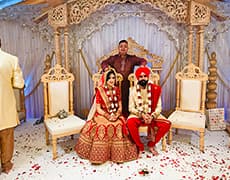Wedding Ceremony
Wedding Ceremony

Vivah (the marriage) Vedic Hindu marriage is viewed as sacramental, which is a lifelong commitment of one wife and one husband. It is the strongest bond between a man and a woman, which takes place in the presence of their parents, relatives, and friends.
Vedic Hindu marriage is viewed as sacramental, which is a lifelong commitment of one wife and one husband. It is the strongest bond between a man and a woman, which takes place in the presence of their parents, relatives, and friends. This an errevocable commitment for a lifetime.For a Hindu, marriage is the only way to continue the family, and thereby repay, his debt to his ancestors. The most important thing is that all the Hindu God and Goddesses are also united in this. Marriage is for spiritual growth and a way of learning many things in life through experiece. In other words, it is a perfect way of following the holy law of the Creator. There are eight ways of getting married.
Steps to follow for the ceremony :
Vaag-daan, Tilak & Sagun (Engagement):
It is a commitment by the bride’s parents to complete the marriage of a future date acceptance by the parents of bridegroom.
Ganesh, Navagrah Puja and ‘Chura’ Sait or Shantipath:
Lord Ganesh is worshipped for success of the ceremony. Chura is given by the brides’ maternal uncle Mama as a blessing and well wishing for her married life. Offering Chunni to the bride to signify that from this time onwards she is the breater of the respect fo the groom’s family.
Sehra and Badhu Grahaagaman:
Groom’s dressing with Sehra and Garland and proceeding to the bride’s house.
Milani:
A warm welcome and greeting of the groom’s parents by bride’s parents and other close family members with garlands and gifts mostly cash. Aarati offered to the groom.
Jaimala:
Formal acceptance of each other by bride and bridegroom with garlands.
Madhupark:
Reception of bridegroom by bride’s father with yogurt and honey.
Homa and Laja Hom:
Establishing the fire and offering of Samagri into the fire. In the first four rounds graings are offered in the fire by the bride and bridegroom which are given to her by her brother. That signifies that she is leaing her family to join husband’s family.
Parikrama:
Mostly when all the rituals i.e. Ashmarohan (Shilarohan), feras, gathagan and Saptpadi are performed together they take seven rounds around the fire. If all of these are performed separately they take the only four rounds. First four rounds are dedicated for four aims of life i.e. Dharma (righteiousness to follow the rules of religion, duty, morality and spirituality) Artha (wealth for livelihood, sharing with poor and misfortuante, to work hard and to earn money with right means) Kaam (love, physical and mental support and satisfaction, dedication between husband and wife throughout life Moksha (liberation from this world of suffering by abiding the law of household life).